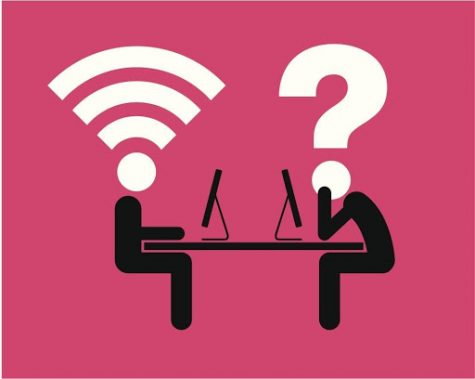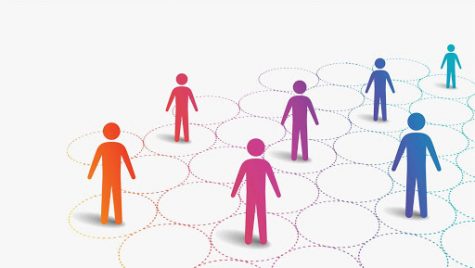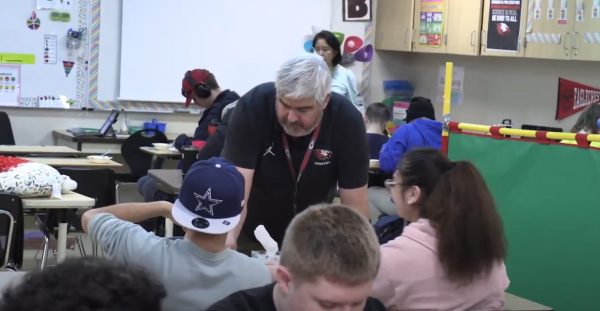Is Remote Learning A Danger to Students Mental Health and Education?
Teachers and staff members point of views on the current situation, involving Covid-19 and the recent shift to full remote leaning.
According to The Chicago Tribune, a recent nationwide study on teachers and students wellness during the COVID-19 pandemic has shown that “46% of teachers reported encountering student mental health concerns such as anxiety, depression, academic stress, trauma and grief more often than they did before the pandemic.” As the number of COVID-19 cases continues to rise in the United States, including our surrounding communities, our government system is still trying to figure out the best way to stop this pandemic.
Unfortunately for us, that means remote learning. Since this is still all new to everybody, the remote learning system is definitely not up to its full potential and efficiency for students to learn. Therefore, students seem to be struggling with more challenges as we all eagerly wait for this pandemic to end.
We took some time to talk to a variety of students and staff at Eaglecrest High School to determine the current struggles people are facing with remote learning during COVID-19 and what the staff is trying to accomplish to make this shift easier and less stressful. Most, if not all, students could agree that their biggest issue with remote learning has been how much they are able to procrastinate due to lack of motivation.
“Like any other high school honor student this shift has not been beneficial when I have become unmotivated to do school, along with not being able to see my friends taking a toll on my mental happiness, as they were and are my main source for joy,” Megan Wilcox, a sophomore at Eaglecrest stated. Many teenage students rely on social interaction with friends as their escape when school becomes too much for them mentally. Being able to take the weekend to spend time with one another, and really just forget about the stress of school is what has been scientifically seen to keep students mentally engaged in their education. With our current struggle facing COVID-19, teenagers have been at a disadvantage when it comes to seeing friends, getting that time to get out of the house and enjoy themselves again.
Kristina Henley, a senior at Eaglecrest, said, “Trying to stay on task during zoom calls is what changed. I mean in class I was fine but sitting at home listening to someone on a computer isn’t realistic anymore. It’s just more stressful too, having my 8-year-old brother at home and he’s screaming during his class.” And students aren’t the only ones who have noticed the struggle of remote learning. Medical professionals such as counselors have seen a drastic change across the board of students’ grades changing.
“All students have been impacted from this pandemic,” An anonymous medical professional states. “A students are becoming B students and B students are now barely passing their classes.” Many of the students agreed with this statement.
“I used to be a solid A and B student but now I beg my teachers for B’s and worry constantly about my GPA,” Abigail Goodwin, a sophomore, said. Not only that but as finals are coming closer, students are overwhelmed with the amount of work given to them daily. With students’ mental health slowly going downhill and teachers continuing to give more work despite having only shortened, 50 minutes classes, there has been a wide range of lack of motivation.
“A challenge would be the motivation, it’s almost like I’ve completely lost it. We go from seeing our teachers every day telling us what we need to do, to having to be an adult and manage our own lives. We are only teenagers and they expect so much from us,” stated Jordan Novak, a junior at Eaglecrest.

“My time management is either amazing and I get all of my work done or I fall into a depressive episode and I can’t get anything done. There’s no middle ground really,” says Novak. Novak, just like many other students, has seen depression becoming a more common thing in high school students since covid, isolation, and now remote learning.
“My biggest struggle is probably my internet and wifi connection. My mom works at home so it’s quite loud at my house and our internet isn’t the strongest. Focusing is also a struggle. It is much easier when in a classroom than being at home all day.” And it seems as though there are actually quite a large amount of students who are struggling with the same things. Things like internet connection, depressive feelings, anxiety motivation and more are a huge part of what current students are going through to maintain those GPAs. It definitely doesn’t make it any easier with the isolation from friends and family.
Aside from the struggles students are facing with technology, grades, mental health, and isolation, students are also struggling to reach out to teachers. Multiple students reported a lack of communication between teachers and students. As emails are being sent out to teachers awaiting a response or action, it seems as though some students are not getting emails back.
An anonymous student stated, “I have been struggling a lot with remote learning, I finally had the courage to email my teachers for help after a rough mental week. I emailed my teacher to inform her that I completed my two essays and she never responded nor put in the grade.” Frustrated and eager to maintain a good grade, this student did acknowledge that the teacher may be busy but the longer they wait the more anxious and stressed they feel about their grades.
“If we have shorter days of school shouldn’t teachers be faster at responding to emails or at least have more time to at least help students rather than 50-minute classes?” the student asks as they still wait for a response. Besides a lack of communication, students have also been reporting the lack of social interaction they have had and how that has affected them. In this generation, it is considered normal for teenagers to go out and socialize with friends constantly, but what happens when they no longer can? Several students, including Pablo Maldonado, a junior at Eaglecrest, have stated that it is more difficult for them to not be able to see their friends and family.
“Not seeing people I care about and staying home all the time already in a not healthy environment definitely made my mental health worse,” Pablo stated. With Eaglecrest being such a diverse community, there are definitely personal challenges that come with remote learning including different household situations.

As we move forward with remote learning until further notice, students strive and hope to see it develop in a positive way. A way to which communication with teachers grows stronger, allowing stress levels and high expectations set on students decreases with the help of teachers, giving feedback. With these positive developments, mental health should, in theory, improve across the board in high school students. Serious mental health issues in students get pushed under the rug daily. Bringing attention to this issue, listening to one another, and most importantly, talking about how you are feeling contributes to these positive developments in student academics during this pandemic.
Karina Gofshteyn contributed to this article

Described as passionate and independent, editor Rhyan Herrera has been in Nest Network for three years. After this year, she plans on going to a college...






